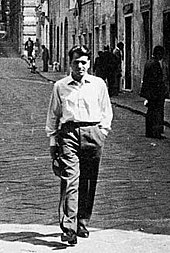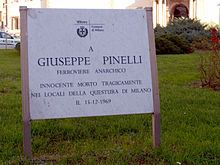Giuseppe Pinelli
You can helpexpand this article with text translated fromthe corresponding articlein Italian.(January 2021)Click [show] for important translation instructions.
|
Giuseppe Pinelli | |
|---|---|
 Pinelli in 1969 | |
| Born | October 21, 1928 |
| Died | December 15, 1969(aged 41) Milan, Italy |
| Cause of death | Defenestration |
| Nationality | Italian |
| Occupation | Railroad worker |
| Movement | Anarchism |
Giuseppe "Pino" Pinelli(21 October 1928 – 15 December 1969) was an Italian railroad worker andanarchist,who died while being detained by thePolizia di Statoin 1969. Pinelli was a member of theMilan-based anarchist association named Ponte della Ghisolfa. He was also the secretary of the Italian branch of theAnarchist Black Cross.His death, believed by many to have been caused by members of the police, inspiredNobel PrizelaureateDario Foto write his famous play titledAccidental Death of an Anarchist.
Early life[edit]

Pinelli was born in Milan to Alfredo Pinelli and Rosa Malacarne.[1]His family was working-class in one of the poorest areas of post-World War IMilan. Although he had to work in many low-income jobs, such as waiter and warehouseman,[1]in order to make ends meet, he nonetheless found the time to read many books and become politically active throughout his youth.[1]Among other political activities, he also worked with the anarchist group that published the weekly paperIl Libertario(The Libertarian).[2]
In 1944, Pinelli was a member of theItalian resistance movementwithin the Franco Brigade, and worked with a group of anarchist partisans that introduced him tolibertarianthought.[3]In 1954, he found work as a railroad fitter. In 1955, Pinelli married Licia Rognini, whom he had met at an evening class ofEsperanto.[2]During the 1960s, he continued anarchist activism. He organized young anarchists in the Gioventù Libertaria (Libertarian Youth) in 1962.[1]In 1965, he helped found the Anarchist Association named afterSacco and Vanzetti.He also founded the Ponte della Ghisolfa association (named after the nearby bridge) in 1968.[1]
Suspicious circumstances surrounding his death[edit]

On 12 December 1969, a bomb exploded at thePiazza Fontanain Milan; it killed 17 people and injured 88.[5]Pinelli was picked up, along with other anarchists, for questioning regarding the attack.[2]Just before midnight on 15 December 1969, Pinelli was seen to fall to his death from a fourth-floor window of the Milan police station.[6]His death was widely believed to have been caused by members of the police.[7]Three police officers interrogating Pinelli, including CommissionerLuigi Calabresi,were put under investigation in 1971 for his death; legal proceedings concluded it was due to accidental causes,[8][9]citing active illness.[10][11][12]He was 41, and was survived by his wife and two young daughters.[10]
Since his death, Pinelli's name was cleared,[6]and the far-rightOrdine Nuovowas accused of the 1969 Piazza Fontana bombing.[5]In 2001, threeneo-fascistswere convicted,[13][14]a sentence that was overturned in March 2004;[5]a fourth defendant, Carlo Digilio, was a suspectedCIAinformant who became a witness for the state and received immunity from prosecution.[14][nb 1]Calabresi was later killed by two shots from a revolver outside his home in 1972.[15]In 1988, formerLotta ContinualeaderAdriano Sofriwas arrested with Ovidio Bompressi andGiorgio Pietrostefanifor Calabresi's murder.[16]The charges against them were based on testimony provided 16 years later by Leonardo Marino, an ex-militant who confessed to the murder of Calabresi under order from Sofri. Claiming his innocence, Sofri was finally convicted after a highly contentious trial in 1997.[17]
In 2022, as part of an investigative podcast about the Piazza Fontana bombing byIl Fatto Quotidiano,[18]the then 99-years-old General Gianadelio Maletti, former number two ofServizio Informazioni Difesa,the secret service of Italy'sMinistry of Defencebetween 1971 and 1975, who was definitively sentenced to 12 months in prison for the misdirections on the Piazza Fontana investigations and had been at large in South Africa since 1980, discussed the death of Pinelli.[10]He described Pinelli's suicide as "a hoax", as GeneralVito Micelihad reportedly confided to him.[18]Brigadier Vito Panessa was also quoted as saying that one of the policemen who were in the room of Calabresi that night had joked: "Pinelli asked for it that night."[18]According to Panessa, there was not just an unexpected incident involving somewhat harsh policemen but someone who had taken revenge on Pinelli, who persisted in not confessing after three days of illegal interrogation.[18]Maletti concluded: "Pinelli refuses to answer questions. The interrogators then resort to stronger means and threaten to throw him out the window. They jerk him and force him to sit on the windowsill. With each negative response, Pinelli is pushed a little further towards the void. Finally, he loses his balance and falls."[18]
In popular culture[edit]
Pinelli's death is the inspiration forDario Fo's playAccidental Death of an Anarchist,although in the original script his name was not mentioned explicitly.[2]The political documentary film12 dicembre(1972) directed byGiovanni Bonfantiabout Pinelli's death was based on an idea byPier Paolo Pasoliniand included an interview to Pinelli's mother and wife.[19]His death inspired the paintingFuneral of the Anarchist Pinelliby Italian artistEnrico Baj.[2]InPiazza Fontana: The Italian Conspiracy(2012), Pinelli was portrayed byPierfrancesco Favino.[20]Hints of his death are also in the songs "La ballata del Pinelli" (1969, with various versions), "Asilo 'Republic'" (1980) byVasco Rossi,and "Quarant'anni" (1993) by theModena City Ramblers,among others.[21][22]
See also[edit]
Notes[edit]
- ^The Italian justice uses a system of state witnesses, who are known aspentitiorcollaboratori di giustizia(collaborators with justice) to fight against terrorism and the mafia.
References[edit]
- ^abcdeFinzi, Paolo (December 2005)."Giuseppe 'Pino' Pinelli (1928–1969): the 17th victim of the Piazza Fontana bombing".Sicilia Libertaria.Retrieved19 April2024– via Kate Sharpley Library.
- ^abcdeHeath, Nick (9 November 2006)."Pinelli, Giuseppe 'Pino', 1928–1969".Libcom.org.Retrieved19 April2024.
- ^"Giuseppe Pinelli Italian anarchist militant (1928–1969)".Daily Bleed's Anarchist Encyclopedia.2008. Archived fromthe originalon 25 January 2008 – via Recollection Books.
- ^Foot, John(2014). "Divided Memories in Italy. Stories from the Twentieth and Twenty-first Centuries". In Hannes Obermair; et al. (eds.).Erinnerungskulturen des 20. Jahrhunderts im Vergleich – Culture della memoria del Novecento al confronto.Hefte zur Bozner Stadtgeschichte/Quaderni di storia cittadina. Vol. 7. Bozen-Bolzano: City of Bozen-Bolzano. pp. 182–185.ISBN978-88-9070-609-7.
- ^abc"1969: Deadly bomb blasts in Italy".BBC News.12 December 1969.Retrieved19 April2024.
- ^abBohlen, Celestine (26 September 1997)."Dispute in Italy Is Conjuring Up Its Terrorist Past".The New York Times.p. 2.ISSN0362-4331.Retrieved19 April2024.
- ^Clark, Martin; Foot, John (20 July 1998)."Italy: Terrorism of Italy".Encyclopædia Britannica Online.Retrieved17 July2011.Updated through the years.
{{cite web}}:CS1 maint: postscript (link) - ^"Né omicidio né suicidio: Pinelli cadde perché colto da malore".La Stampa(in Italian). 29 October 1975.ISSN1122-1763.
- ^Fleury, Matthew (1985)."Dario Fo".Bomb Magazine.Archived fromthe originalon 28 August 2017.Retrieved19 April2024.
The events upon which the play is based took place in 1969. A bomb exploded in the center of Milan, near the Duomo. Sixteen died. The police blamed the anarchists, one of whom, Giovanni Pinelli [sic], they seized. Later on he was thrown from a window at police headquarters. There is considerable evidence that Pinelli's death was murder, not an accident as the police claimed, so the titleAccidental Death of an Anarchist,is ironic. We are sure it was not an accident... It was murder... But this is the official police characterization of the event. The case was filed as an 'accidental death'.
- ^abcNerazzini, Alberto; Sceresini, Andrea (11 December 2020)."'Misero Pinelli sul davanzale. Fu così che poi cadde e morì'".Il Fatto Quotidiano(in Italian).ISSN2037-089X.Retrieved19 April2024.
- ^Romeo, Ilaria (21 October 2022)."La storia di Giuseppe Pinelli, morto senza verità né giustizia".Collettiva(in Italian).Retrieved19 April2024.
- ^Romeo, Ilaria (15 December 2022)."Il caso Pinelli, storia di un anarchico in cerca di giustizia".Collettiva(in Italian).Retrieved19 April2024.
- ^"Trio get life for 1969 Milan bombing".CNN.30 June 2001. Archived fromthe originalon 16 January 2007.Retrieved19 April2024.
- ^abWillan, Philip (1 July 2001)."Three jailed for 1969 Milan bomb".The Guardian.ISSN1756-3224.Retrieved19 April2024.
- ^"Assassinato per strada il commissario Calabresi".La Stampa(in Italian). 17 May 1972.ISSN1122-1763.
- ^Sasso, Cinzia (1 August 1988)."Un 'cassiere' raccoglieva armi e denaro delle rapine".La Repubblica(in Italian).ISSN0390-1076.Retrieved19 April2024.
- ^Foschini, Paolo (23 January 1997)."Definitive le condanne per Sofri e gli altri".Corriere della Sera(in Italian).ISSN2499-0485.Retrieved19 April2024.
- ^abcdeMaiolo, Tiziana (15 December 2020)."Omicidio di Giuseppe Pinelli, così la polizia buttò l'anarchico fuori dalla finestra".Il Riformista(in Italian).ISSN2704-8039.Retrieved12 May2024.
- ^"Pasolini in lotta: '12 dicembre'".Cinefilia Ritrovata(in Italian). 1 July 2015.Retrieved19 April2024.
- ^Marcellan, Francesca (12 December 2023)."12 dicembre: la memoria di piazza Fontana e il film 'Romanzo di una strage'".Volere la luna(in Italian). Archived fromthe originalon 13 December 2023.Retrieved19 April2024.
- ^Nawrocki, Norman (2013).Cazzarola!: Anarchy, Romani, Love, Italy (A Novel).PM Press. p. 172.ISBN978-16-0486-315-4.
- ^"Giuseppe Pinelli".Centro studi libertari(in Italian). 2020.Retrieved19 April2024.
External links[edit]
- La ballata del Pinelli [Ballata dell'anarchico Pinelli, o Il feroce questore Guidaat Canzoni contro la guerra (in Italian)
- La ballata del Pinelliat Nelvento.net (in Italian)
